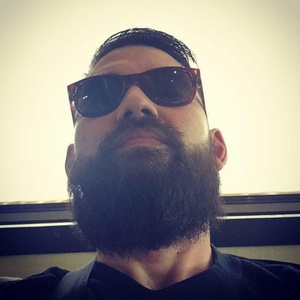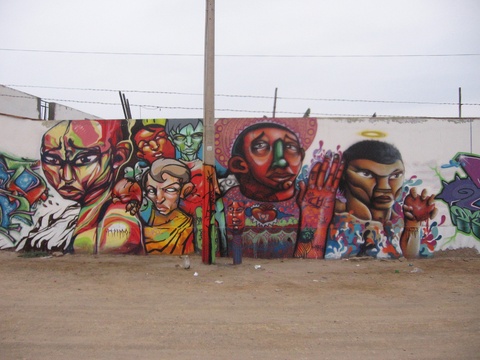Graffiti is his habitat. Your place in the world. The space where you unleash your creativity, share and deepen friendships.
Gianmarco Higuchi discovered his calling at an early age. He listened to rap, drew and was attracted to colors, but he was missing the final link, the decisive step: painting in the street.
He had no one to go out with and transfer his art to the walls, until he became friends with a graffiti artist who pronounced three magic words: “Let's paint.” This is how light was made. His first work was a piggy on a wall of the Public Charity of Lima. “It was show 1 ,” he remembers with a nostalgic smile.
Gianmarco is a member of Dedos Manchados en la Jungla de Concreto (DMJC), the oldest graffiti movement in Peru. They have been together for 18 years now. He really enjoys how the various ideas are reflected on the wall until they compose a collective work. “It is the integration of everyone,” he says.
They paint where they find a wall. It is difficult, but they have a better chance of finding space on the outskirts of traditional Lima.
Facing a bare wall to fill it with colors and shapes is a challenge, he says, even more so if it is not done at floor level, but at a certain height. Gianmarco, whose nickname is Fater, makes sketches before starting to paint on the wall, but sometimes he improvises.
What do you like most about graffiti? “The opportunity to share with other people, my people. You had a bad day the day before, you start painting, you laugh to death, and they made your day. It is a sharing. It happened to me a month ago, I was stressed about work and I decided 'I'm not working today, I'm going to paint', and it was completely relaxing."
The communion that graffiti generates extends to the public. Even many who consider it an act of vandalism rectify their perception:
“Wherever there is graffiti you will always see people sharing, chatting, not necessarily even with the people who paint, but with the people who pass by. It is a very interesting visual phenomenon, because you arrive at a completely painted wall and start to draw, and people start to say 'hey, how are you going to paint, you are ruining the public road', but a couple of hours pass, they come back and They see what you are doing and say 'how nice'. “That change is really crazy.”
Despite those who still do not know how to appreciate graffiti, coloring Lima finds followers.
“We live in a Lima that is so gray, so flat, that we try to add color to the few spaces there are. We appreciate the people who value that.”
Although it is difficult to find walls, there are other alternatives for graffiti artists in Peru: art galleries or companies that hire urban artists, since graffiti works as an advertising hook.
Opinions on the matter are divided, he says. Some believe that graffiti should not leave walls because it becomes commercial. He says that we have to evolve, especially considering that making a living from art in Peru is complicated.
In Peru there is a strong graffiti movement, he reveals. “We don't have to envy anyone.” In South America, Brazil is the best.
Gianmarco studied graphic design at the Catholic University of Peru. He never found opposition from his parents to turn to art. On the contrary, he always had the support of his father, who wanted to be an artist but couldn't because his father (Gianmarco's grandfather) did not allow him to.
Rather than as a designer, he prefers to define himself as a graphic artist. Graffiti is not the only artistic expression he dedicates himself to, but it is the one he enjoys the most and influences his digital works.
Strong experiences—good or bad, happy or painful—are stored in your head and then emerge to materialize as art. You don't necessarily propose it or plan it, that's where the subconscious works.
NIKKEI POTENTIAL
Gianmarco recently participated in a meeting of young Nikkei artists convened by the plastic artist Haroldo Higa and organized by the Peruvian Japanese Association.
It was an unprecedented proposal in which artists of Japanese origin from various fields participated: painting, sculpture, industrial design, engraving, graffiti, fashion design, photography, etc.
The experience was positive. Gianmarco highlights the breadth of the call and that it allowed many artists to meet, exchange data and share work, and suggests the possibility of forming a collective like the one he has with graffiti artists. In addition, he hopes that there will be more meetings and that artists from other branches such as music will be called.
He highlights the diversity of artistic proposals he found, each one with its own imprint. “I was surprised by the potential that we Nikkei have to make art,” he says. The meeting could be the starting point to deepen the dissemination of art made by Nikkei.
Be careful, art made by Nikkei, not “Nikkei art”. Gianmarco avoids labels, attempts to label artists or their work. He is an artist and that's it, without bias, he says. Each artist creates their identity.
Now, his Japanese origin has shaped his character. “It influences my way of being, of acting. Although I have not been raised traditionally, I have certain values that have always been instilled in me at home, and I always try to bring that out and I value it a lot, because in the end it says a lot about you. I use it a lot at work, as a child I was always told 'you have to be punctual in meetings' and I try to be punctual. There are many things about the culture that have been instilled in me and I apply it in everything on a daily basis.”
ARTISTIC SENSITIVITY
Peru stands out for its gastronomy, but when it comes to art it is an unappetizing country. Gianmarco would like more people to visit galleries, go to exhibitions, talk about art, see plays, etc. Peru would be a richer country, he points out.
Suggests promoting free workshops to encourage the practice of art in sectors that do not have access to it, great talents could emerge, children or young people who would discover their talent for drawing or dancing, or who have an artistic vocation and cannot develop it due to opposition or lack of support from their parents.
“Visit galleries without fear, without any prejudice. We all have to learn, we are sowing seeds so that the culture continues to grow.”
Gianmarco, who has a company that provides health services through sports (another of his passions), is an omnivorous consumer of art. He likes everything. “I'm the sensitive one in the family,” he laughs. “Art makes you more sensitive.”
Note:
1. Great.
© 2017 Enrique Higa









